| |
|
|
|
|
| |
An International Flashpoint |
|
|
|
| |
|
|
|
|
| |
Abuse of Aboriginal Title & Rights |
|
Wilderness: Awe vs Annihilation |
|
| |
Corrupt Politics: the Downward Spiral |
|
The Struggle of Environmentalism |
|
| |
Corporate Greed: Stump to Dump |
|
A Brave Stand: Betty! |
|
| |
|
|
|
|
| |
|
|
| |
|
|
|
|
| |
Wilderness: Awe vs Annihilation
Throughout history, human beings have viewed the wilderness as both an entity of awe and a cause for annihilation. In neocolonial countries such as Canada, wilderness is viewed as the opposite of civilization and development and therefore the forests continue to be slaughtered at break neck speed. Within a hundred years the ancient temperate rainforests of British Columbia (BC) have been decimated. Today we know that the rare and vanishing groves of big trees are a keystone of biodiversity yet forest produts companies have no limits to their greed. Weyerhauser's industrial carnage of Vancouver Island from 1999 to 2004 included the Upper Walbran Forest, where irreplaceable monumental cedars, the celebrated "Tree of Life" for coastal First Nations, were destroyed (right). |
|
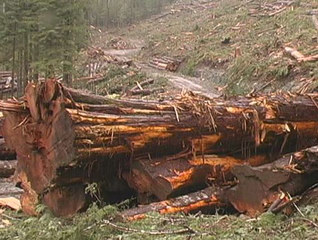
Weyerhaeuser, Vancouver Island, 2003.
Photo: Richard Boyce |
|
| |
|
|
|
|
| |
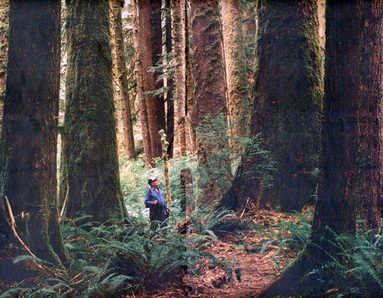 |
|
Spirit Transformed: A Journey from Tree to Totem Vickers, Roy Henry Vancouver, BC, Canada Raincoast Books 1996 No ISBN First Edition Hardcover Fine Condition Near Fine 19 cm x 29 cm Herger, Bob, Photographer Chronicle of the transformation of an 800-year-old yelllow cedar tree in the Walbran Valley on Vancouver Island, carved by renowned First Nations artist Roy Henry Vickers into a 30-foot salmon totem pole that was unveiled at the commencement of the 1994 Commonwealth Games in Victoria. Profusely illustrated in full colour photos, 'Spirit Transformed' is a tale of metamorphosis and renewal on several levels - personal, artistic, mythic, and actual for both the yellow cedar tree and the man who carved it. |
|
| |
|
|
|
|
| |
|
|
|
|
| |
|
|
 |
|
| |

Looking Out #7, by M. N. Y, 2006.
Photo: Rocking Raven
A giant spruce tree on Haida Gwaii is among the biggest trees in BC that have survived industrial logging (right). Much of the work by Haida artist and longtime forest activist Michael Nicoll Yahgulanaas is inspired by Haida Gwaii. An example is the watercolour (above) which is part of a series called "Looking Out." Locking Out. As a political artist, Yahgulanaas aims to bring public affairs and art together as in his illustrated tale of clearcut logging on Haida Gwaii: "The Last Voyage of the Black Ship." See: Haida Manga – Tree Spirit. |
|

Big Sitka spruce on Haida Gwaii, 2007
Photo: Justin Zoll |
|
| |
|
|
 |
|
| |
Big Trees and Totem Poles The natural history of BC is an inextricable part of indigenous cultural heritage. Monumental red cedar trees, for example, provide the material needed for totem poles, canoes and other Northwest Coast carving traditions such as the mask by Guujaaw (right). The Haida carver has witnessed the grievous loss of "totem trees" and other types of aboriginal heritage trees on Haida Gwaii.
Giindajin Haawasti Guujaaw is of the Raven clan of the Haida Nation. He was born in Masset on the northern part of Haida Gwaii. He is born of the Gakyaals Kiiqawaay Skedans Ravens like his mother. His father, Chiits Gitnaii, is an Eagle from the Yakoun River" Guujaaw – Carver (SpruceRoots). As president of the Council of the Haida Nation, Guujaaw leads the battle to protect Haida Gwaii from multinational logging companies
|
|

Raven mask by Guujaaw.
Photo: Simon Davies |
|
| |
|
|
|
|
| |
Trees as Individuals Also European settlers have been inspired by the abundance and magnificence of nature on the Northwest Coast. Emily Carr (1871 – 1945) is one of the earliest female artists in Canada. Born to English immigrants in Victoria, the capital city of BC, Carr lived most of her life on Vancouver Island. She often travelled to remote First Nations villages and wilderness locations to paint directly from nature. Two main themes in her work are totem poles and Northwest Coast nature, especially majestic ancient cedars, and dark primaeval forests (right). Carr described the magical feeling of being inside a big tree grove: "The interior. It's so deep and quiet and still. It could heal a person, body and soul. I get a sense of some presence breathing there. God's too big to be squeezed into a stuffy church, but I feel Him there in the spaces between the trees. |
|
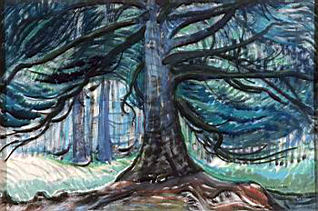
"Dancing Tree" by Emily Carr, c. 1900.
Art Gallery of Greater Victoria |
|
| |
|
|
 |
|
| |
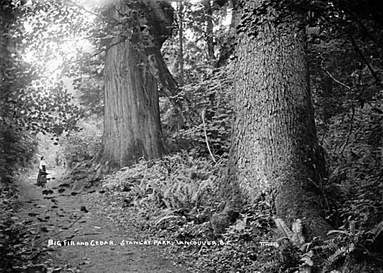
"Big Fir and Cedar. Stanley Park," c. 1900.
Photo: Vancouver Public Library |
|
Big Trees as Cathedrals of Nature One of the first native authors to publish in Canada was E. Pauline Johnson (1862 – 1913). She lived her last years in Vancouver and wrote a book about Stanley Park, published in 1911. In it she describes a big tree grove, such as the one in the c. 1900 photo (left): "There is a well known trail in Stanley Park that leads to what I always love to call the Cathedral Trees, that group of some half dozen forest giants that arch overhead with such superb loftiness. But in all the world there is no cathedral whose marble or onyx columns can vie with those straight, clean, brown tree boles that teem with the sap and blood of life. There is no fresco that can rival the delicacy of lace work they have festooned between you and the far skies. . . She will never originate a more faultless design, never erect a more perfect edifice." |
|
| |
|
|
|
|
| |
Few big trees survive where Vancouver today sprawls. Only in Stanley Park can one imagine the former magnificence of the ancient forest. Here Emily Carr painted a cedar grove in 1909 (right).

"National Geographic Cedar," Stanley Park.
Photo: P. Wright |
|

"Inside a Cedar Forest," 1909.
Painting by Emily Carr |
|
| |
|
|
|
|
| |
A lone specimen (above) may have been a member of the cedar grove. Unbelievably, this famous grove, known as the "Cathedral Trees," was destroyed in the 1960s by city officials. The surviving cedar, measuring 14 metres in circumference and 40 metres tall, was featured in the National Geographic magazine in 1978. Sadly, the so called "National Geographic Cedar" fell in October 2007 (right) due to gale force winds. Such storms are causing the giant trees of Stanley Park that escaped logging to succumb, especially as they no longer are protected by the surrounding ancient forest on which Vancouver sprawls.
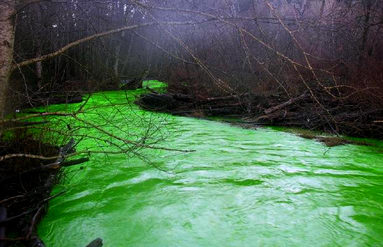
mmmmm
mmm |
|

Fallen ancient cedar, October 2007.
Photo: anon |
|
| |
|
|
 |
|
| |
|
Gallery of Nature and Wildlife in Goldstream Park |
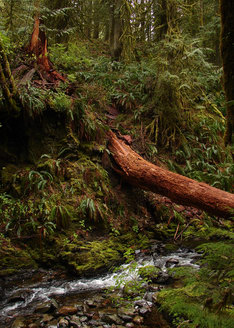 |
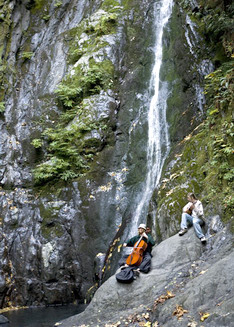 |
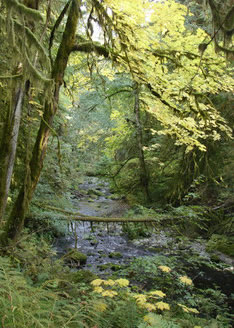 |
|
Goldstream Forest |
Niagara Falls 150 ft (45.7 m) |
Goldstream River |
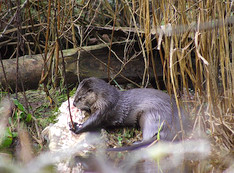 |
 |
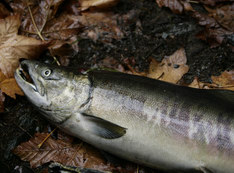 |
River Otter |
Goldstream Falls |
Sockeye Salmon |
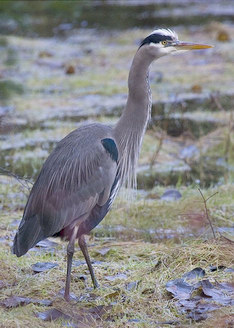 |
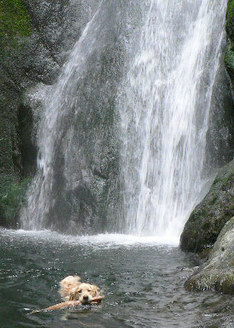 |
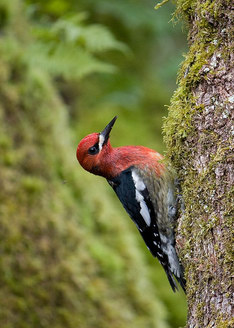 |
Heron |
Niagara Falls |
Red Headed Woodpecker |
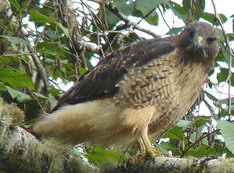 |
 |
 |
Golden Hawk |
Salmon After Spawning |
Stellar Jay |
|
|
| |
|
|
 |
|
| |
BC's vanishing big trees are worth far more to the longterm economy while standingthan they are as chips, lumber and pulp. In the introduction to his guidebook "Big Trees" (right), Randy Stoltman wrote that humans can only make headway towards solving the ongoing conflict between conservation and industrial resource extraction by having a personal connection with ancient forests. Stoltman encouraged people to visit the big trees and he led the environmental fight to save several ancient groves. In 1986 he founded the "Register of Big Trees" which was later taken over by the government and logging industry. After the premature 1994 death of Stoltman in a mountain hiking accident, many photos of the big trees and maps of their location were lost and the big tree project was more or less abandoned.

"Cheewhat Cedar," Carmanah Walbran Park
Photo: Bryon Fry |
|

"Big Trees," bookcover.
Photo. Randy Stoltman, 1988
Canada's largest tree is the "Cheewat Cedar" on Vancouver Island (left), measuring 18.34 m (60.2 ft) in circumference and 55.5 m (182 ft) in height. It is almost beyond belief that this enormous matriarch, a western red cedar with an estimated age of 2,000 years, is as old as Christianity. Not far from her is the tallest known Sitka spruce in the world, the "Carmanah Giant." Not discovered by Europeans until 1988, this monumental tree is 95 m (312 ft) tall. Shockingly, so close to Victoria, continues to be ravaged and converted to plantations. |
|
| |
|
|
 |
|
| |
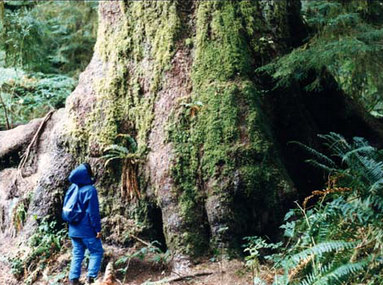
"Heaven's Tree," Carmanah Walbran Forest.
Photo: David McEowan |
|
Carmanah, Artistic Visions of an Ancient Rainforest WCWC 1989 October 18 - WCWC releases Carmanah, Artistic Visions of an Ancient Rainforest . The 168 page hard cover art book puts forward an impassioned argument for preserving the entire Carmanah Valley and features the work of 70 of Canada's best artists. WCWC continues to call on people to exercise their democratic right and express their opinion about Carmanah to the elected officials.
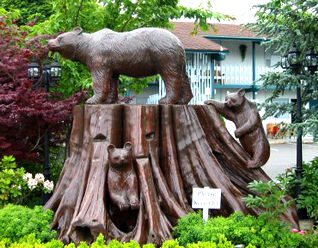
"Heaven's Tree"
Photo: David McEowan |
|
| |
|
|
|
|
| |

Big spruce, Carmanah Walbran Park, 2008
Vancouver Island, British Columbia
In 1988, the BC big tree expert Randy Stoltmann discovered the world's tallest known Sitka spruce in the Carmanah Valley on Vancouver Island. At the time this Crown (public owned) forest land was being clearcut logged by MacMillan Bloedel. To save the big trees from destruction, a campaign was launched. Artists were invited to the Carmanah Valley to portray the beauty of the giant trees and a book of the resulting works of art was published: Carmanah: Artistic Visions of an Ancient Rainforest (1989)
Carmanah Walbran Provincial Park, on the southwest coast of Vancouver Island, is home to some of the world's largest spruce trees.
The Carmanah Giant, at 95 metres, is thought to be the tallest Sitka spruce in the world, although it is less than 400 years old! There are much older, gnarled cedars estimated to be well over 1,000 years old clinging to the side hills.
The lower Carmanah valley was declared a provincial park in 1990, as a result of the eventual discovery of the Sitka Spruce 'legendary giant' by conservationist Randy Stoltmann in 1988.
The Walbran and upper Carmanah Valleys were added to the park in 1995, thereby completing the protection of the Carmanah Creek watershed and the southern portion of the Walbran Creek watershed.
Visitors come to Carmanah to be entranced by the spell cast around big trees - trees so large that you have to expand your consciousness in order to assimilate the almost overwhelming impression made by such enormous biomass. Carmanah Walbran Park protects an extremely complex forest ecosystem, including the large Sitka Spruce ecosystem that comprises two per cent of BC's remaining old-growth forest. The park's spruce groves attain a biomass (weight of plants per hectare) of nearly twice that of a tropical forest. This dynamic system has developed over thousands of years and only functions properly if left totally undisturbed. |
|
The big trees of Cathedral Grove have become a symbol of the urgent need for global legislation to make the logging of ancient trees and forests an illegal act. Canada's hypocrisy is exposed by the fact that it donates to an international fund dedicated to saving the Amazonian rainforest yet continues to eradicate its own vanishing rainforest and cowtow to the wood products industry.
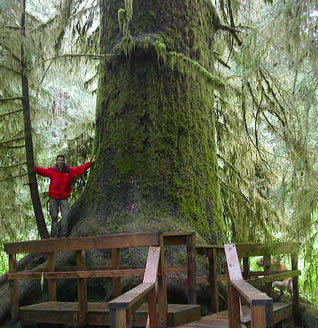
"Heaven's Tree," Carmanah Walbran Park
Vancouver Island, British Columbia |
|
| |
|
|
|
|
| |

"Big Betty," unprotected giant Douglas fir, 2003
Photo: Ingmar Lee
According to Ingmar Lee, who reported and named "Big Betty," she does not feature the deeply corrugated bark typical of ancient Douglas firs. His theory is that because the gigantic tree is located on the edge of a rocky canyon, she grew very slowly and therefore did not develop the normal bark splits found in fast growing trees. He believes that given the enormous size of "Big Betty," she must be extremely old, possibly well over a thousand years.
Another one of the last giant firs which not long ago covered most of southwestern BC is the "Red Creek Fir" (right). Located in an active logging area on Vancouver Island, the big tree was reported in 1976. It towered at 97.6 m (320 ft) before losing its top in a storm. Today, at 73 m (241 ft), it is still the largest known Douglas fir in the world. |
|
An exceptional record breaking Douglas fir tree was discovered in 2003 (left) in the unprotected Upper Walbran Forest of Vancouver Island which today is being massacred by heli logging. This rare survivor of industrial logging is called "Big Betty" in honour of Betty Krawczyk, the forest activist who was arrested in 2003 for blockading a nearby logging road and jailed for ten months.
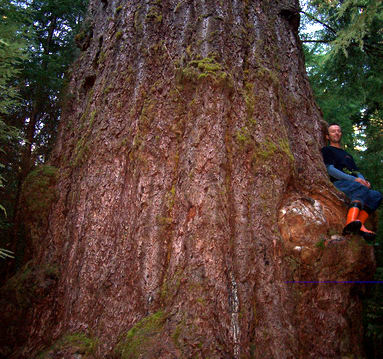
"Red Creek Fir," Port Renfrew
Vancouver Island, British Columbia |
|
| |
|
|
 |
|
| |

Red Creek Fir, Port Renfrew
Photo: Myklicious

mmmmm
mmm |
|
Inspired by his love of big trees, the leader of the German Green Party of Lower Saxony Stefan Wenzel appealed to BC's forest minister to reduce the rate of deforestation in the province: "There is no way around the sustainable use of our forests and our biological habitats, not in British Columbia, not in Germany, and not in any other part of the world. It is time to choose a new path, to search for a compromise in order to save our most irreplaceable biological habitats. I therefore hope that the last remnants of the ancient wild forests of BC, the incompariable heritage of humankind, will be preserved" Part of Our Soul.
|
|
| |
|
|
|
|
| |

"Forest Primeval," a scene in Clayoquot Sound.
Painting by David McEown, 2000 |
|
| |
|
|
 |
|
| |
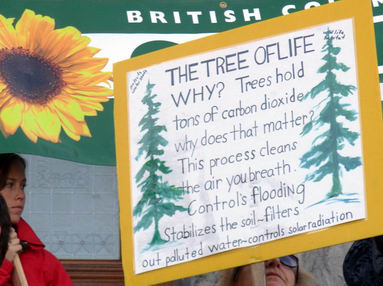
mmmmmmmmmmmmmm
mmmmmm
"The BC logging industry has long bought the government, forestry institutions
and the science which all conspire and collude together to convert BC forests to pulp, 2X4’s and raw logs
for export. In BC the forestry 'science' is bought that proves that black is white. BC forest professionals
are the primary propagandists and greenwashers – bought for the purpose of bringing scientific justification
these voracious and rapacious crimes against nature" Ingmar Lee,
Compromise with a Chainsaw (Counterpunch). |
|
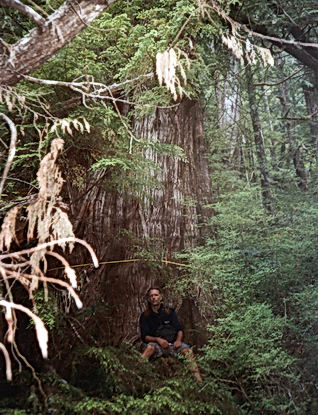
Klaskish cedar.
Photo: Ingmar Lee |
|
| |
|
|
|
|
| |
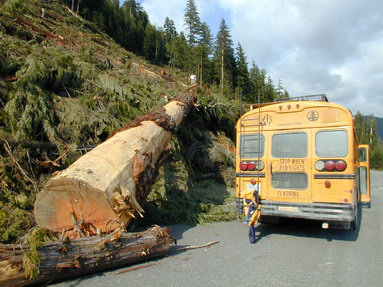
mmmmm
mmm |
|
|
|
| |
|
|
|
|
| |
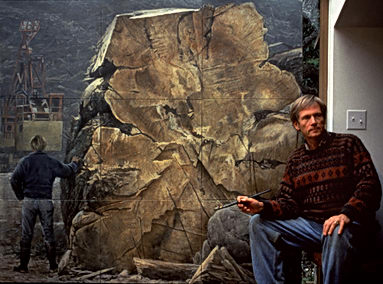
Robert Bateman in his studio, 1993.
With painting entitled "Self Portrait." |
|
One of the participating artists in the Carmanah project was the renowned painter of birds and wildlife Robert Bateman who described his 1993 work "Self Portrait with Big Machine and Ancient Sitka" as an "environmental painting" which was "an attack on the kind of logging that we do"(below). Bateman was horrified by the annihilation of ancient trees he witnessed in the Carmanah Valley: "We had to go along the logging road to the end of the area and past this huge Sitka spruce that had been cut down. I show that picture in almost all of my talks as it was an old tree when Christopher Columbus came to America – and what is it now, junk mail or 2 X 4's?"
The Carmanah conservation campaign inspired Artists for Nature, a foundation established in 1990 in the Netherlands to bring artists from all over the world to locations in need of nature protection. In BC, nature provides a rich source of inspiration for artists and an important source of revenue from nature tourism. Yet many species are on the brink of extinction due to habitat loss: Endangered Species & Ecosystems at Risk. |
|
| |
|
|
|
|
| |

Old growth Douglas fir logs for sale, 2009.
Island Timber Frame Company, Vancouver Island |
|
Ancient Forest Extermination The government of BC persists with its lowly greenwashing politics: on the one hand it advertises internationally its natural heritage of ancient cedar tree giants, while on the other hand it encourages the extermination of these vanishing trees by facilitating corporate cronies in their forest plunder. Island Timber Frame, one of many similar companies, openly flogs itself as "the best source of Douglas fir, red and yellow cedar and other prime lumber in North America" and shamelessly pictures old growth corpses (left). Such unethical commerce must be rejected: academics studying the Northwest Coast must place their results in the activist service of preventing the loss of big trees, rather than aiding and smokescreening government and big business with phoney scholarship profundities that help greenwashing. |
|
| |
|
|
|
|
| |
Above is "a study of an ancient grove of western red cedar, surrounded by moss covered western hemlock in various stages of life's cycle. These shade tolerant trees form a continual regenerating climax forest, thousands of years old. Water from clouds and ocean mist is captured on this thin, steep, strip of land, backed by the mountains. This water flows and collects in falls and pools around the giant moss covered boulders and roots" David McEown: Forest Primeval. On the right side of the painting, one can see the ugly scar of a clearcut mountain, a stark reminder of the ever present menace to the forest of industrial logging.
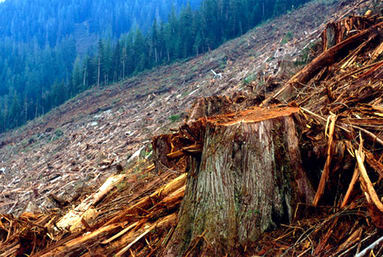
Ancient forest destruction in the Elaho, Sim Valley, 1998
Photo: Jeremy Sean Williams |
|

Wild sockeye salmon
Photo: Jeremy Sean Williams
One hundred and fifty years of industrial logging in BC has wiped out countless genetic sub species of salmon by destroying their habitat. Each salmon species was adapted to the specific conditions of the native stream where it was spawned, yet this scientific knowledge has not stopped the forest industry from clearcut logging vital salmon streams and watersheds. See: Save the Streams (Ocean Society of British Columbia). |
|
| |
|
|
|
|
| |

"Help!" Caribou extinction, 2006
Kids For Caribou
The case of the failure to save the old growth forest habitat of the Mountain Caribou from destruction by the forest industry is especially tragic (above). Already in 2002, a long report on the crisis was prepared by the BC government with a portrait of the species on its front cover (right). See: Recovery Strategy. Despite the long history of public interest and political controversy in the recovery strategy of the caribou, it has not succeeded due primarily to the refusal of companies to stop their old growth logging operations. |
|

Mountain Caribou
Painting by Michael Hames | |
| |
|
|
|
|
| |
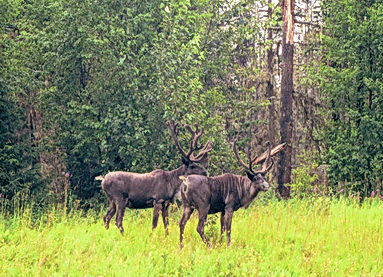
mmmmmmmm
mmmmmmmmmmm |
|
|
|
| |
|
|
|
|
| |
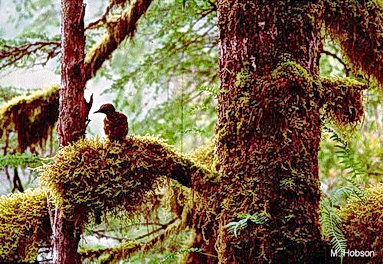
Marbled Murrelet, Vancouver Island
Photo: Mark Hobson
The Vancouver Island Marmot (Marmota vancouverensis) is one of the rarest creatures on Earth (right). Considered the most beautiful of the world's 14 marmot species, there are no animals born in the wild left today. Not long ago, the cheerful whistlings between marmots pierced the silence of the alpine meadows, but today there is mostly silence. Logging companies Weyerhaeuser, TimberWest and Island Timberlands are directly responsible for the extinction of this species in the wild: their high altitude clearcutting of the prime marmot habitat makes them environmental outlaws: Beaufort Mountain Range.
Ingmar Lee comments: "The public needs to know that wild born Vancouver Island marmots are now totally extinct, having passed away into oblivion, without obituary, several years ago. That means that all of the 200 marmots that are alive today are laboratory bred specimens which have been born and raised in captivity"
Vancouver Island's Marmot (1 July 2007, "Not Out of the Woods Yet"). |
|
Marbled Murrelets (Brachyramphus marmoratus) are critically endangered in BC. Murrelets build their nests in the mossy covered branches of ancient trees and their survival is dependent on old growth forest habitat (left). BC has no endangered species legislation that adequately protects vulnerable species such as the murrelet from the impact of logging companies and rare pockets of primaeval forests continue to be clearcut. BC's discredited Wildlife Act does not even prevent the logging of nesting habitat during the migratory bird season. On the urgent need for b legal protection of BC's biodiversity, see: Rich Wildlife, Poor Protection (David Suzuki Foundation, 2007).
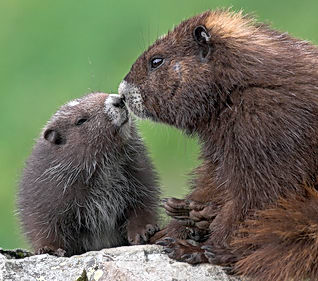
Vancouver Island Marmots, 2006
Photo: Oli Gardner |
|
| |
|
|
|
|
| |
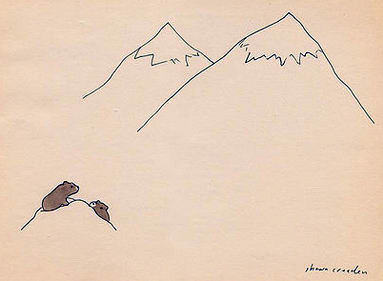
"Vancouver Island Marmot." Drawing by Shawn Creeden
Photo: artist
"Given the rapidly dwindling 'refugia tufts' of primaeval forests out there, in a vast and growing sea of cutover lands one expects that any species which are dependent on such forests must be concentrating in these places in unnatural densities. That makes the felling of such patches even more criminal than usual. And of course, the sorry farce of 'variable retention' whereby generaly least or nonmerchantable stands are left in road bights so when they blow down the next year they're easier to salvage, or the even more farcical "single – tree – every – 100 – metres – variable – retention" model we see so much of can never support even non primaeval dependent species" Ingmar Lee. |
|
In his 2005 exhibition of photos and paintings, New York City artist Shawn Creeden included a drawing of two of the surviving individuals of the Vancouver Island Marmot, "the rarest and most endangered animal in the world" seen in their ravaged mountain habitat (left).
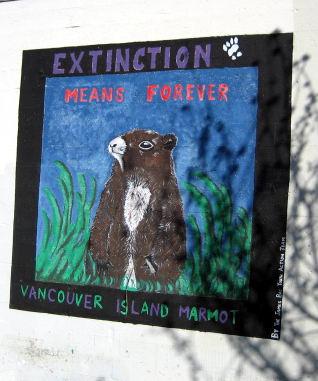
"Extinction Means Forever." Mural
Photo: Lori & Tod |
|
| |
|
|
|
|
| |
Another critically endangered species in BC is the Northern Spotted Owl (Strix occidentalis caurinais) seen on the right. Its population has fallen by more than 80 percent since 1991 due primarily to the clearcut logging of its habitat. BC is believed to have only six breeding pairs plus 11 single owls in the wild. In 2005 several environmental groups launched a federal court case in a historic bid to save the spotted owl: See the Sierra Legal Defense Fund: Press Release.
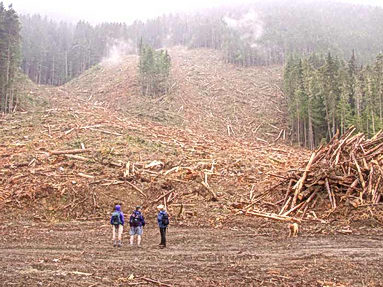
Clearcut logging, Manning Provincial Park, 2004
Photo: Joe Foy |
|
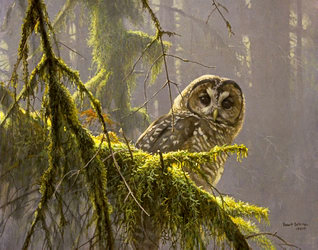
Northern Spotted Owl
Photo: Jared Hobbs
A description of the clearcut (left): "Here I was, standing in an area surrounded by one of the most popular parklands in the province, in a forest set aside for the preservation of Canada's most endangered bird species, the Northern Spotted Owl, and it was a sea of stumps slash and big heaps of busted timbers in house sized burn piles" Joe Foy, National Campaign Director: Western Canada Wilderness Committee. |
|
| |
|
|
|
|
| |
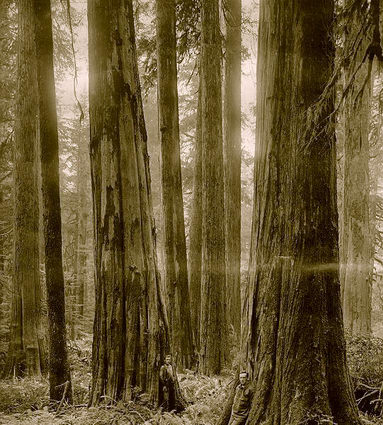
mmmmm
mmm
|
|
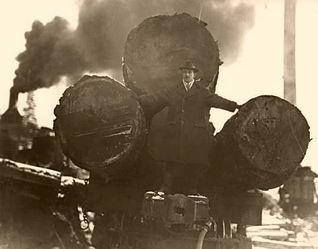
Logs from the ancient Capilano forest, 1926
Photo: Vancouver Archives
German forester Gottlob Koenig wrote in 1841 of the consequences of deforestation: "Everyone knows that when the first tree was cut, it was the beginning of civilization. But the felling of the last tree will surely be the end of civilization. We move between these two aspects of civilized life. But the moment of the latter lies in our hands."
The case of the Capilano River Valley, now part of the urban sprawl of Vancouver, should be a lesson by which to learn. Here the land and resources of the indigenous Capilano people were destroyed in the early 20th century by the massive clearcut logging of the ancient trees (right), by a hydro power plant that ruined the salmon bearing river, by roads and real estate development and so on. |
|
| |
|
|
|
|
| |
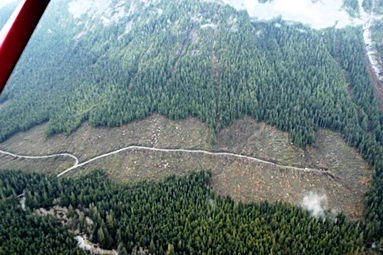
Clearcut, Great Bear Rainforest, October 2004
Photo: Ian McAllister |
|
An aerial photo (left) shows a clearcut by International Forest Products (Interfor) in the Great Bear Rainforest, which is supposed to be "ecologically" managed. Frenchmans Creek (in Nuxalk called "Nuu'klut," Home of the Steelhead) is a critical spawning stream in Nuxalk Territory.
A description of the clearcut: "It looks pretty much like your standard clearcut to me (30 – 40 ha), which is one of the reasons why many are worried about Ecologically Based Management. There's more paper planning, assessments and justification but at the end of the day nothing much changes. There is certainly no alternative stand management silvicultural system employed here and not even any wildlife trees left in the clearcut" Michael Copeland, Ecoforestry Institute. |
|
| |
|
|
|
|
| |
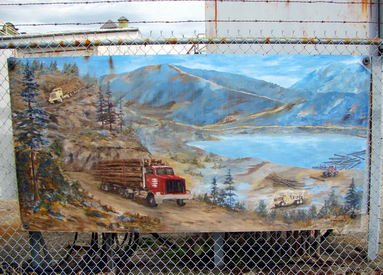
The Granby Wilderness Society promotes solutions to the threats facing the endangered Granby Grizzly, watersheds, ecosystems, and community security in the Southern Interior of BC. See: Giant Cedars Project. The Granby Wilderness Society calls for an immediate transition from the multinational corporate liquidation of the magnificent wild forests of British Columbia to a locally controlled and ecologically responsible community forestry. Ancient trees – like the Granby grizzly – are becoming extinct: "We are wiping out the diversity of plant and animal life dependent on moist and shady ecosystems, and the cool refuge provided to wildlife during hot summer days. It is a moral and ecological crime to clearcut these last cedar forests."
To fund the conservation efforts of the Granby Wilderness Society, an auction of artwork donated by artists was held that included a painting entitled "They Call it Fiber" by Nadine Dechiron (right). Born and raised in France, she moved to BC in the 1970s: "Ayant été impliquée pendant plus de dix ans dans le mouvement écologique en C.B., quand je pense 'nature sauvage' je pense 'en rétrécissement.' Les arbres ne sont pas respectés en tant qu’êtres vivants de la forêt, mais abattus en masse comme 'fibre' pour les scieries insatiables."
She explains how the insanity of industrial forestry in British Columbia inspired her environmental painting: "When I think wilderness, I think 'shrinking.' Trees are not respected as living forest beings, but mass murdered as 'fiber' for insatiable mills." |
|

"They Call it Fiber," 2004
Painting by Nadine Dechiron |
|
| |
|
|
|
|
| |
|
What we are doing to the forests of the world is but a mirror reflection of
what we are doing to ourselves and to one another (Mahatma Gandhi) |
|
|
| |

Ancient cedar grove logged and flooded for hydro power, Inland Rainforest, southeastern British Columbia
Photo: Storm and Mick Grabowski |
|
| |
|
|
 |
|
| |
|
|
| |
©
Credits & Contact |
|
| |
|
|
|
|

